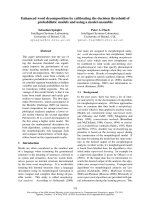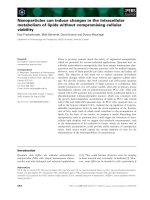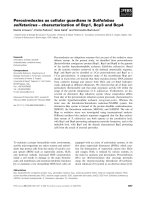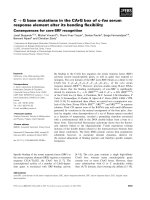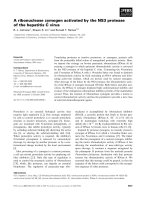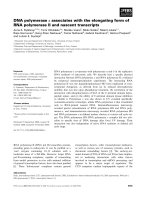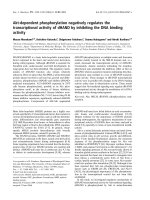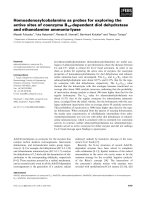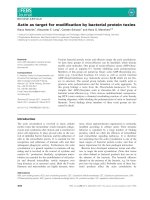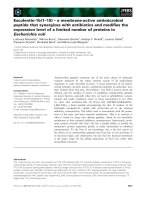Báo cáo khoa học: Homoadenosylcobalamins as probes for exploring the active sites of coenzyme B12-dependent diol dehydratase and ethanolamine ammonia-lyase docx
Bạn đang xem bản rút gọn của tài liệu. Xem và tải ngay bản đầy đủ của tài liệu tại đây (289.4 KB, 10 trang )
Homoadenosylcobalamins as probes for exploring the
active sites of coenzyme B
12
-dependent diol dehydratase
and ethanolamine ammonia-lyase
Masaki Fukuoka
1
, Yuka Nakanishi
1
, Renate B. Hannak
2
, Bernhard Kra
¨
utler
2
and Tetsuo Toraya
1
1 Department of Bioscience and Biotechnology, Faculty of Engineering, Okayama University, Tsushima-naka, Okayama, Japan
2 Institut fu
¨
r Organische Chemie, Universita
¨
t Innsbruck, Innsbruck, Austria
AdoCbl participates as coenzyme for the enzymes that
catalyze carbon skeleton rearrangements, heteroatom
eliminations, and intramolecular amino group migra-
tions [1–3]. For example, diol dehydratase (EC 4.2.1.28)
and ethanolamine ammonia-lyase (EC 4.3.1.7) catalyze
the dehydration of 1,2-diols and the deamination of eth-
anolamine to the corresponding aldehydes, respectively
[4–6]. These reactions proceed by a radical mechanism,
and an essential early event in all the AdoCbl-dependent
rearrangements is the generation of a catalytic radical
(adenosyl radical) by homolytic cleavage of the coen-
zyme’s Co-C bond [1,7].
Recently, the X-ray structures of several AdoCbl-
dependent enzymes have been solved in complexes
with cobalamins [8–13]. Spatial isolation of the radical
intermediates in the active site cavity seems to be the
common strategy for the so-called ‘negative catalysis’
of the Re
´
tey’s concept [14]. The interactions of
the coenzyme’s adenine moiety with enzymes were
revealed with methylmalonyl-CoA mutase [15,16], diol
Keywords
adenosylcobalamin; coenzyme B
12
;
homoadenosylcobalamins; diol dehydratase;
ethanolamine ammonia-lyase
Correspondence
T. Toraya, Department of Bioscience and
Biotechnology, Faculty of Engineering,
Okayama University, Tsushima-naka,
Okayama 700–8530, Japan
Fax: +81 86 2518264
Tel: +81 86 2518194
E-mail:
(Received 11 May 2005, revised 20 July
2005, accepted 1 August 2005)
doi:10.1111/j.1742-4658.2005.04892.x
[x-(Adenosyl)alkyl]cobalamins (homoadenosylcobalamins) are useful ana-
logues of adenosylcobalamin to get information about the distance between
Co and C5¢, which is critical for Co-C bond activation. In order to use
them as probes for exploring the active sites of enzymes, the coenzymic
properties of homoadenosylcobalamins for diol dehydratase and ethanol-
amine ammonia-lyase were investigated. The k
cat
and k
cat
⁄ K
m
values for
adenosylmethylcobalamin were about 0.27% and 0.15% that for the regu-
lar coenzyme with diol dehydratase, respectively. The k
cat
⁄ k
inact
value
showed that the holoenzyme with this analogue becomes inactivated on
average after about 3000 catalytic turnovers, indicating that the probability
of inactivation during catalysis is almost 500 times higher than that for the
regular holoenzyme. The k
cat
value for adenosylmethylcobalamin was
about 0.13% that of the regular coenzyme for ethanolamine ammonia-
lyase, as judged from the initial velocity, but the holoenzyme with this ana-
logue underwent inactivation after on average about 50 catalytic turnovers.
This probability of inactivation is 3800 times higher than that for the regu-
lar holoenzyme. When estimated from the spectra of reacting holoenzymes,
the steady state concentration of cob(II)alamin intermediate from aden-
osylmethylcobalamin was very low with either diol dehydratase or ethanol-
amine ammonia-lyase, which is consistent with its extremely low coenzymic
activity. In contrast, neither adenosylethylcobalamin nor adeninylpentylco-
balamin served as active coenzyme for either enzyme and did not undergo
Co-C bond cleavage upon binding to apoenzymes.
Abbreviations
AdoCbl, adenosylcobalamin or coenzyme B
12
; AdoEtCbl, adenosylethylcobalamin; AdoMeCbl, adenosylmethylcobalamin or homocoenzyme
B
12
; AdePeCbl, adeninylpentylcobalamin.
FEBS Journal 272 (2005) 4787–4796 ª 2005 FEBS 4787
dehydratase [17], glutamate mutase [18], and lysine
5,6-aminomutase [13]. Based on the structures, steric
strain models of activation and cleavage of the Co-C
bond were proposed [17,18]. In diol dehydratase, tight
interactions between the enzyme and coenzyme at
both the cobalamin moiety and the adenine ring of
the adenosyl group seem to produce angular strains
and tensile force that likely contribute to labilization
of the Co-C bond [17] (Fig. 1A). Difference in the
specificity for the adenosyl group among enzymes
may reflect the difference of the adenosyl group-bind-
ing sites of the enzymes. From simulation of the EPR
spectra of reacting holoenzymes, it was suggested that
that the distances between Co(II) of cob(II)alamin
and substrate radicals are 11 A
˚
in ethanolamine
ammonia-lyase [19,20], ‡ 10 A
˚
in diol dehydratase
[21], 6.6 A
˚
in glutamate mutase [22], and 6.0 A
˚
in
methylmalonyl-CoA mutase [23]. These suggestions
were corroborated by the X-ray structures of glutam-
ate mutase [10], methylmalonyl-CoA mutase [8], diol
dehydratase [9], and glycerol dehydratase [12]. The
difference in the distances between substrate radical
and Co(II) may cause different ways of radical trans-
fer from coenzyme to substrate. For the access to
substrates, ribosyl rotation (Fig. 1A) and pseudorota-
tion models of this process have been proposed for
A
B
Fig. 1. Modeling studies of diol dehydratase on adenosyl radical formation and access to substrate (A) and partial structures of AdoCbl ana-
logues used in this study (B). (A) The steric strain model of the Co-C bond cleavage by diol dehydratase and the ribosyl rotation model of
access of the adenosyl group to substrate [17]. Left, Superimposition of AdoCbl over that of enzyme-bound AdePeCbl at the cobalamin moi-
ety without cleavage of the Co-C bond. Center, The same superimposition at both the cobalamin moiety and the adenine ring with the Co-C
bond cleaved and the Co-C distance kept at a minimum (‘proximal’ conformation). Right, Superimposed with the ribose moiety of the adeno-
syl group rotated around the glycosidic linkage so that C5¢ is closest to C1 of the substrate (‘distal’ conformation). Stick model represents
the adenosyl group of AdoCbl. Residue numbers in the a subunit. (B) Partial structures of AdoCbl analogues used in this study. R represents
the Cob (upper axial) ligand.
Coenzymic functions of homoadenosylcobalamins M. Fukuoka et al.
4788 FEBS Journal 272 (2005) 4787–4796 ª 2005 FEBS
diol dehydratase and glutamate mutase, respectively
[17,18].
It would be beneficial to get information about the
distance between Co and C5¢, which is critical for the
Co-C bond activation, especially for the enzymes
whose X-ray structures are not yet available. A series
of [x-(adenosyl)alkyl]cobalamins, i.e. homoadenosyl-
cobalamins (Fig. 1B), have been synthesized [24–26].
These analogues might be useful as probes for explor-
ing the active sites of AdoCbl-dependent enzymes. In
this paper, we have investigated the coenzymic proper-
ties of these homologues for diol dehydratase and
ethanolamine ammonia-lyase.
Results
Coenzymic activity of the coenzyme analogues
in the diol dehydratase and ethanolamine
ammonia-lyase reactions
Coenzymic activity of homoadenosylcobalamins was
first examined using AdoCbl-dependent diol dehydra-
tase as a test enzyme. Figure 2A indicates the time cour-
ses of the diol dehydratase reaction using AdoMeCbl
and AdoEtCbl at a concentration of 10 lm. When 300
times higher concentration of apoenzyme than that for
AdoCbl was used, low but distinct coenzyme activity
was observed with AdoMeCbl. As shown in Table 1, its
k
cat
value was about 0.27% that for AdoCbl, and the
rate of mechanism-based inactivation (k
inact
) with this
analogue was as slow as that with the regular coenzyme.
As judged from the k
cat
⁄ k
inact
value, the holoenzyme
with this analogue becomes inactivated after about 3000
catalytic turnovers on average. This indicates that the
probability of inactivation during catalysis is almost
500 times higher than that with AdoCbl. The catalytic
efficiency (k
cat
⁄ K
m
) of the holoenzyme with AdoMeCbl
was 0.15% that for the regular coenzyme.
Fig. 2. Time courses of reactions with homoadenosylcobalamins as
coenzymes. Propionaldehyde and acetaldehyde formed by enzy-
matic reactions were assayed by the alcohol dehydrogenase-NADH
coupled method, as described in the text. The amounts of apo-
enzyme used are given below in parentheses. Reactions were initi-
ated by adding each coenzyme at a concentration of 10 l
M. (A) Diol
dehydratase reaction. AdoCbl (solid line) (0.01 unit); AdoMeCbl
(dashed line) (3 units). (B) Ethanolamine ammonia-lyase reac-
tion. AdoCbl (solid line) (0.01 unit); AdoMeCbl (dashed line) (34
units).
Table 1. Coenzyme activity and kinetic parameters for the analogues in the diol dehydratase and ethanolamine ammonia-lyase reactions
(determined at 37 °C).
Coenzyme
Diol dehydratase Ethanolamine ammonia-lyase
k
cat
b
k
inact
b
(min
)1
)
k
cat
⁄ k
inact
c
· 10
)4
K
m
c
(lM)
k
cat
⁄ K
m
· 10
)6
(M
)1
Æs
)1
)
K
i
c
(lM)
k
cat
b
k
inact
b
(min
)1
)
k
cat
⁄ k
inact
· 10
)4
(s
)1
)(%) (s
)1
)(%)
AdoCbl
a
366 (100) 0.014 157 0.80 458 447 (100) 0.14 19
AdoMeCbl 1.0 (0.3) 0.022 0.3 1.7 ± 0.3 0.6 ± 0.1 1.1 ± 0.3 0.6
e
(0.1) 0.64 0.006
AdoEtCbl 0.0 ( 0.0) 1.5 ± 0.5 0.0 ( 0.0)
AdePeCbl 0.0 ( 0.0) 0.27
d
0.0 ( 0.0)
a
From [55].
b
Determined by the alcohol dehydrogenase-NADH coupled assay method.
c
Determined by the MBTH method and Lineweaver–
Burk plots. Averages of two independent experiments are shown.
d
From [27].
e
From the initial velocity.
M. Fukuoka et al. Coenzymic functions of homoadenosylcobalamins
FEBS Journal 272 (2005) 4787–4796 ª 2005 FEBS 4789
In contrast, neither AdoEtCbl nor AdePeCbl was an
active coenzyme even when examined with 3000 times
higher concentration of apoenzyme. These inactive
analogues behaved as strong competitive inhibitors, as
judged from their inhibition constants (K
i
). This fact
indicates that they can not serve as coenzymes
although they are bound tightly to the apoenzyme.
The observation that the K
i
value for AdePeCbl is
smaller than those for the other analogues [27] is
consistent with the previous report on the effects of
[x-(adenosin-5¢-O-yl)alkyl]cobalamins [28].
Coenzymic activity of the homoadenosylcobalamins
was measured with AdoCbl-dependent ethanolamine
ammonia-lyase as well. The time courses of the etha-
nolamine ammonia-lyase reaction using AdoMeCbl
and AdoEtCbl at a concentration of 10 lm are shown
in Fig. 2B. Again, very low but distinct coenzymic
activity was observed with AdoMeCbl when deter-
mined with 1500 times higher concentration of
apoenzyme, but the holoenzyme with AdoMeCbl
underwent rapid inactivation. Kinetic constants shown
in Table 1 indicate that the coenzymic activity (k
cat
)of
this analogue is about 0.13% that of AdoCbl, as
judged from the initial velocity. The rate of mechan-
ism-based inactivation (k
inact
) with this analogue was
five times faster than that with the regular coenzyme.
The k
cat
⁄ k
inact
value for AdoMeCbl indicates that the
holoenzyme with this analogue undergoes inactivation
after about 50 catalytic turnovers on average, and that
this probability of inactivation is 3800 times higher
than that with AdoCbl. On the other hand, AdoEtCbl
and AdePeCbl were totally inactive as coenzymes even
when measured with 1500 times higher concentration
of apoenzyme, in accordance with the results using
diol dehydratase.
Spectroscopic studies
Figure 3A–D shows the spectra of free AdoCbl, its
homologues and AdePeCbl, respectively. When these
Fig. 3. Spectral changes of homoadenosylcobalamins upon incubation with apoenzymes of diol dehydratase and ethanolamine ammonia-
lyase in the presence of substrates. Free AdoCbl (3.5 l
M) (A), AdoMeCbl (3.8 lM) (B) AdoEtCbl (3.8 lM) (C), or AdePeCbl (3.8 lM)(D)in
35 m
M potassium phosphate buffer (pH 8.0) containing 1 M propane-1,2-diol (solid lines). Spectra of the photolyzed analogues were also
taken (broken lines). Apodiol dehydratase (100 unitsÆmL
)1
,6.4lM) was incubated with AdoCbl (3.5 lM) (E) AdoMeCbl (3.8 lM) (F), AdoEtCbl
(3.8 l
M) (G), or AdePeCbl (3.8 lM) (H) in 35 mM potassium phosphate buffer (pH 8.0) containing 1 M propane-1,2-diol, in a volume of 1.0 mL.
Spectra were taken at 5 min of incubation (solid lines). After 10 min, the enzyme was denatured by adding 6
M guanidine. HCl ⁄ 0.06 M citric
acid. The pH of the mixture was 2.6. After 10 min at 37 °C, the mixture was neutralized by adding 200 lLof1
M potassium phosphate buf-
fer (pH 8.0) and 70 lLof5
M KOH, and the spectrum was taken (dotted lines). Samples were finally illuminated at 0 °C for 10 min with a
250-W tungsten light bulb at a distance of 15 cm (broken lines). Apoethanolamine ammonia-lyase (50 unitsÆmL
)1
, 8.0 lM) was incubated
with AdoCbl (3.5 l
M) (I), AdoMeCbl (3.8 lM) (J), AdoEtCbl (3.8 lM) (K), or AdePeCbl (3.8 lM) (L) in 31 mM potassium phosphate buffer
(pH 8.0) containing 0.2
M ethanolamine and 5 mM 2-mercaptoethanol, in a volume of 1.0 mL. Spectra were measured at 5 min of incubation
(solid lines). Spectra of the denaturated and neutralized (dotted lines) and illuminated (broken lines) samples were measured as described
above for E–H. Spectra are corrected for dilution.
Coenzymic functions of homoadenosylcobalamins M. Fukuoka et al.
4790 FEBS Journal 272 (2005) 4787–4796 ª 2005 FEBS
analogues of AdoCbl were incubated with apodiol
dehydratase in the presence of substrate (propane-1,2-
diol), the spectra of analogues underwent bathochro-
mic shifts of the a-band by 10–20 nm (Fig. 3F–H) as
compared with those of free counterparts. The extents
of the Co-C bond cleavage of these analogues were
negligible although that of AdoCbl was estimated to
be 85% from Fig. 3E. Upon denaturation of the
enzyme-cobalamin complexes by guanidine under aci-
dic conditions, the spectra resembling free analogues
were obtained. They were then changed to the spec-
trum of aquacobalamin upon photoillumination. From
these results, it was concluded that the steady state
concentration of cob(II)alamin intermediate from
AdoMeCbl is very low in consistence with its extre-
mely low coenzymic activity, and that neither analogue
undergoes irreversible cleavage of the Co-C bond upon
binding to apoenzyme.
We have reported previously that the complexes
of diol dehydratase with adeninylbutylcobalamin or
AdePeCbl showed resistance to photolysis of the Co-C
bond as compared with the free counterparts [27].
Figure 4C,D indicates that both of the enzyme-bound
AdoMeCbl and AdoEtCbl are much more resistant to
photolysis of their Co-C bond upon photoillumination
than the free counterparts (Fig. 4A,B). The conver-
sions of the enzyme-bound analogues to OH-Cbl were
approximately 10% for AdoMeCbl and 2% for
AdoEtCbl, respectively, although that of the free coun-
ter parts was 100% under the conditions. This suggests
that the upper axial ligand-derived radicals, such as
adenosylmethyl and adenosylethyl radicals, readily
recombine with the cob(II)alamin intermediate to
re-form original organocobalamins. Such a property of
these coenzyme analogues would be reasonably
explained by the fact that adenine-anchored radicals
are formed by photolysis of their Co-C bond and kept
associated with the active site. The adenine moiety
would be trapped or anchored in the so-called ‘aden-
ine-binding pocket’ of the enzyme whose structure has
been analyzed by X-ray crystallography [17].
Similar experiments were carried out with ethanol-
amine ammonia-lyase. Again, none of AdoMeCbl,
AdoEtCbl and AdePeCbl underwent significant spec-
tral changes upon binding to the enzyme in the pres-
ence of ethanolamine, although they showed red or
blue shift of the a-band by less than 6 nm (Fig. 3J–L).
The steady-state concentrations of cob(II)alamin inter-
mediate were almost negligible with the analogues,
although that with the regular coenzyme was estimated
to be c. 88% from Fig. 3I. This is consistent with its
extremely low coenzymic activity of AdoMeCbl and
with inactivity of the other two analogues. It is also
evident that neither AdoEtCbl nor AdePeCbl under-
goes irreversible cleavage of the Co-C bond upon bind-
ing to ethanolamine ammonia-lyase.
Discussion
The data presented in this paper can be reasonably
explained by our ‘steric strain model’ of the coen-
zyme’s Co-C bond activation upon binding to apo-
enzyme (Fig. 1A) [17]. AdoMeCbl [24] and AdoEtCbl
[29] were reported to be totally inactive as coenzyme
for ribonucleotide reductase, and the latter inactive for
diol dehydratase [27]. The X-ray structure of the diol
dehydratase–AdePeCbl complex revealed that there
are a cobalamin-binding site and an adenine-binding
pocket for AdoCbl [17]. The steric strain model is
based on a modeling study which showed that super-
position of both cobalamin moiety and adenine ring of
AdoCbl on those of the enzyme-bound AdePeCbl is
not possible without cleavage of the Co-C bond. The
adenine ring of the coenzyme would be accommodated
to the adenine-binding pocket in order to obtain the
maximal binding energy. Supposing AdoCbl is tightly
bound by the enzyme at both the cobalamin moiety
and the adenine ring, marked distortions, namely both
Fig. 4. Photostability of the Co-C bond of diol dehydratase-bound
homoadenosylcobalamins. (A, B) Free AdoMeCbl (A) or AdoEtCbl
(B) (3.8 l
M)in35mM potassium phosphate buffer (pH 8.0) contain-
ing 1
M propane-1,2-diol (solid lines). Spectra of the photolyzed ana-
logues were also taken after illumination for 1 min with a 250-W
tungsten light bulk at a distance of 15 cm (broken lines). (C, D)
Apodiol dehydratase (100 unitsÆmL
)1
,6.4lM) was incubated with
3.5 l
M of AdoMeCbl (C) or AdoEtCbl (D) in 35 mM potassium phos-
phate buffer (pH 8.0) containing 1
M propane-1,2-diol, in a volume
of 1.0 mL. Spectra were taken at 5-min of incubation (solid lines).
The mixtures were then illuminated for 1 min under the same con-
ditions as described in (A) and (B), and spectra were taken (broken
lines).
M. Fukuoka et al. Coenzymic functions of homoadenosylcobalamins
FEBS Journal 272 (2005) 4787–4796 ª 2005 FEBS 4791
angular strains and tensile force, are produced that
inevitably break the Co-C bond. We believe that these
are molecular entities of the activation of the coen-
zyme’s Co-C bond by apoenzyme. Pratt speculated
about a similar idea from a chemical viewpoint [30].
The crystal structure of the homolysis fragment
cob(II)alamin also suggested that a major contribution
to Co-C bond activation in AdoCbl-dependent
enzymes would come about ‘by way of apoenzyme
(and substrate) induced separation of the homolysis
fragments, made possible by strong binding of both
separated fragments to the protein’ [31]. A steric strain
model has been proposed by Kratky and coworkers as
well with glutamate mutase [18].
As shown in Fig. 5, if the group inserted between
C5¢ and Co is a methylene, the steric strains induced
upon the binding to apoprotein would be largely but
not completely relieved. Thus, it would be expected
that only a small fraction of the enzyme-bound Ado-
MeCbl undergoes the Co-C bond cleavage. As a result,
only a trace of coenzymic activity was observed with
this analogue. Such speculation is reasonable, because
the modeling study revealed that the Co-C distance is
elongated to at least 3.3 A
˚
and the Co-C bond leans
toward N22 of pyrrole ring B at a C5¢-Co-N22 bond
angle of 52° [17]. If a dimethylene group is inserted
between C5¢ and Co, the steric strains could be com-
pletely relieved. Hence, no cleavage of the Co-C and
thus no activity can be expected. This is the case with
AdePeCbl as well; that is, the steric strains become
invalid with this analogue because of the flexibility of
pentamethylene group [27,32]. Thus, all the data repor-
ted here are consistent with the steric strain model that
we have proposed.
To elucidate the mechanism of enzymatic activation
(labilization) of the coenzyme Co-C bond, the struc-
ture–function relationship of AdoCbl and the role of
each structural component of the coenzyme were
extensively studied using various coenzyme analogues
[24,29,33–35]. Coenzyme analogues, in which one of
the structural components of the coenzyme is substi-
tuted by a closely related group, were synthesized and
examined for coenzymic activity and binding affinity
for the enzyme. It was demonstrated that the adenine
ring and the ribosyl moiety of the adenosyl group are
required for tight binding to the apoenzyme and for
transmitting strains to the Co-C bond, respectively,
both being indispensable for the Co-C bond activation
(catalytic radical formation) and coenzymic function
[27,36–38]. Adeninylethylcobalamin undergoes Co-C
bond cleavage upon binding of apodiol dehydratase,
whereas adeninylpropylcobalamin and other longer
chain homologues do not [32]. These lines of evidence
suggest the presence of adenine-binding site in the apo-
enzyme and that the ‘adenine-attracting effect’ of apo-
enzyme is a major element that weakens the Co-C
bond. However, the specificity for the adenosyl group
is slightly different among AdoCbl-dependent enzymes.
Glycerol dehydratase shows similar specificity for the
adenosyl group [39–42]. In ribonucleotide reductase
Fig. 5. Postulated models of the Co-C bond
activation of AdoCbl and its homologues
upon binding to apoenzyme. Ade, 9-adeni-
nyl; [Co], cobalamin. The regions shown by
oblique lines and shadows indicate the
adenine-binding pocket and the cobalamin-
binding site of enzyme, respectively.
Coenzymic functions of homoadenosylcobalamins M. Fukuoka et al.
4792 FEBS Journal 272 (2005) 4787–4796 ª 2005 FEBS
[24,29,35], the interaction at N3 of adenine is essential
but interaction at 6-NH
2
is less important than those
in diol dehydratase. Ribonucleotide reductase shows
more strict specificity for the ribose moiety than diol
dehydratase. For Aristeromycylcobalamin (AdoCbl
analogue in which the ribosyl oxygen atom is replaced
by -CH
2
-) is 36–44% and 38% as active as AdoCbl in
diol dehydratase [27,43,44] and glycerol dehydratase
[44], respectively, but it serves as a strong competitive
inhibitor for ethanolamine ammonia-lyase [44] and
ribonucleotide reductase [29] and a weak competitive
inhibitor for methylmalonyl-CoA mutase [44]. 2¢-De-
oxyAdoCbl is 31%, 17%, and 5–13% as active as Ado-
Cbl for diol dehydratase [38,45], glycerol dehydratase
[41], and ribonucleotide reductase [29,35], respectively,
but shows only 1–2% activity for methylmalonyl-CoA
mutase [46] or no activity for glutamate mutase [45].
Two series of AdoCbl analogues are of special interest.
[x-(Adeninyl)alkyl]cobalamins [24,27,29,32,47,48] were
useful to know the limit of the distance of Co and N9
of adenine to keep a stable Co-C bond, that is, the
Co-C bond is cleaved with adeninylethylcobalamin but
not with adeninylpropylcobalamin or its homologues
by the binding to diol dehydratase [32]. Among
[x-(adenosin-5¢-O-yl)alkyl]cobalamins that mimic the
posthomolysis intermediate state of AdoCbl [28], C5
and C6 analogues showed the strongest inhibition for
diol and glycerol dehydratases [49] and methylmalonyl-
CoA mutase [50], respectively. These analogues were
shown to be useful to get information about the dis-
tance between Co and C5¢ after homolysis. Recently,
the mechanism-based inactivation of diol dehydratase
by 3¢,4¢-anhydroadenosine has been reported [51].
The evidence for the hypothetical adenine-binding
site was first obtained by biochemical binding experi-
ments [52] and then by X-ray crystallographic analysis
[17]. It should be noted that the three-dimensional
structure of the adenine-binding pocket can reasonably
explain the requirements of the structural components
of AdoCbl for binding and catalysis, but can not pre-
dict the extents of their contributions to the enzyme
catalysis. The structural and biochemical studies are
complementary to each other. In this paper, we report
the coenzymic functions of homoadenosylcobalamins
for diol dehydratase and ethanolamine ammonia-lyase.
It was shown that these analogues would be useful for
obtaining information about the distance between Co
and C5¢, which is critical for Co-C bond cleavage. In
order to conclude whether these coenzyme analogues
are useful probes for exploring the active sites of
AdoCbl-dependent enzymes whose structures have not
yet been solved, we have to await further investigation
with other enzymes whose distance between Co(II) of
cob(II)alamin and substrate radicals are closer than
that of diol dehydratase.
Experimental procedures
Materials
Partial structures of the coenzyme analogues used in this
study are illustrated in Fig. 1B. Crystalline AdoCbl was a
gift from Eisai Co. Ltd. (Tokyo, Japan). AdoMeCbl and
AdoEtCbl were prepared as described before by Gscho
¨
sser
et al. [25], and AdePeCbl as described by Hogenkamp [26].
All other chemicals were reagent-grade commercial prod-
ucts and were used without further purification.
Apoenzymes of recombinant Klebsiella oxytoca diol
dehydratase and Escherichia coli ethanolamine ammonia-
lyase were purified to homogeneity from E. coli JM109 cells
harboring expression plasmids pUSI2E(DD) [53,54] and
pUSI2ENd(EAL) (K. Akita and T. Toraya, to be pub-
lished), respectively.
Enzyme and protein assays
Activities of diol dehydratase and ethanolamine ammonia-
lyase were determined by the 3-methyl-2-benzothiazolinone
hydrazone (MBTH) method [27]. The reaction mixture
contained an appropriate amount of apoenzyme, 15 lm
AdoCbl, 0.1 m propane-1,2-diol or ethanolamine, 50 mm
KCl, and 30 mm potassium phosphate buffer (pH 8.0), in
a total volume of 1.0 mL. After incubation at 37 °C
for 10 min, reactions were terminated by adding 1 mL of
0.1 m potassium citrate buffer (pH 3.6). MBTH hydrochlo-
ride was then added to a final concentration of 0.9 mm,
and the mixtures were incubated again at 37 °C for 15 min.
The concentration of aldehydes formed was determined by
measuring the absorbance at 305 nm. One unit is defined
as the amount of enzyme activity that catalyzes the forma-
tion of 1 lmol of propionaldehyde or acetaldehyde per
minute at 37 °C under standard assay conditions. Apparent
K
i
values for coenzyme analogues were obtained by the
double reciprocal plots at a fixed concentration (1 lm)
of an analogue and varied concentrations (0–10 lm)of
AdoCbl.
The alcohol dehydrogenase-NADH coupled assay
method [55] was also used for the assays of both diol dehy-
dratase and ethanolamine ammonia-lyase. The reaction
mixture contained an appropriate amount of apoenzyme,
10 lm AdoCbl or its analogue, 0.1 m propane-1,2-diol or
ethanolamine, 120 lg of yeast alcohol dehydrogenase,
0.4 mm NADH, and 30 mm potassium phosphate buffer
(pH 8.0), in a total volume of 1.0 mL. Reactions were initi-
ated by adding AdoCbl or its analogue, and a change of
the absorbance at 340 nm was recorded. k
inact
was calcula-
ted from a change in the slope of a tangent to the time
course curve of the reaction thus obtained.
M. Fukuoka et al. Coenzymic functions of homoadenosylcobalamins
FEBS Journal 272 (2005) 4787–4796 ª 2005 FEBS 4793
The protein concentration of purified preparations of the
enzymes was determined by measuring the absorbance at
280 nm. The molar absorption coefficient at 280 nm
(e
M,280
) calculated by the method of Gill and von Hippel
[56] from the deduced amino acid compositions and subunit
structures were 120 500 and 302 400 m
)1
Æcm
)1
for diol
dehydratase and ethanolamine ammonia-lyase, respectively.
Based on the predicted molecular masses, e
1%,280
was calcu-
lated to be 5.81 and 6.21 for the former and latter enzymes,
respectively [57].
Other analytical procedures
The concentrations of organocobalamins were determined
spectrophotometrically after converting them to a dicyano
form by photolysis in the presence of 0.1 m KCN, using
e
367
¼ 30.4 · 10
3
m
)1
Æcm
)1
for dicyanocobalamin [58].
Acknowledgements
This work was supported in part by Grant-in-Aids for
Scientific Research from the Ministry of Education,
Culture, Sports, Science and Technology, Japan, and
from the Japan Society for Promotion of Science
(13125205 and 13480195 to TT) and by the Austrian
Science Foundation (FWF P-13595 to BK). We thank
Ms. Yukiko Kurimoto for assistance in manuscript
preparation.
References
1 Toraya T (2003) Radical catalysis in coenzyme B
12
-
dependent isomerization (eliminating) reactions. Chem
Rev 103, 2095–2127.
2 Banerjee R (2003) Radical carbon skeleton rearrange-
ments: catalysis by coenzyme B
12
-dependent mutases.
Chem Rev 103, 2083–2094.
3 Dolphin D, ed (1982) B
12
, Vol. 2 . John Wiley & Sons,
New York.
4 Lee HA Jr & Abeles RH (1963) Purification and prop-
erties of dioldehydrase, an enzyme requiring a coba-
mide coenzyme. J Biol Chem 238, 2367–2373.
5 Toraya T, Shirakashi T, Kosuga T & Fukui S (1976)
Substrate specificity of coenzyme B
12
-dependent diol
dehydrase: glycerol as both a good substrate and a
potent inactivator. Biochem Biophys Res Commun 69,
475–481.
6 Bradbeer C (1965) The clostridial fermentations of cho-
line and ethanolamine. 1. Preparation and properties of
cell-free extracts. J Biol Chem 240, 4669–4674.
7 Bandarian V & Reed GH (1999) Ethanolamine ammo-
nia-lyase. In Chemistry and Biochemistry of B
12
(Bane-
rjee R, ed), pp. 811–833. John Wiley & Sons, New
York.
8 Mancia F, Keep NH, Nakagawa A, Leadlay PF,
McSweeney S, Rasmussen B, Bosecke P, Diat O &
Evans PR (1996) How coenzyme B
12
radicals are gener-
ated: the crystal structure of methylmalonyl-coenzyme
A mutase at 2 A
˚
resolution. Structure 4, 339–350.
9 Shibata N, Masuda J, Tobimatsu T, Toraya T, Suto K,
Morimoto Y & Yasuoka N (1999) A new mode of B
12
binding and the direct participation of a potassium ion
in enzyme catalysis: X-ray structure of diol dehydratase.
Structure 7, 997–1008.
10 Reitzer R, Gruber K, Jogl G, Wagner UG, Bothe H,
Buckel W & Kratky C (1999) Glutamate mutase from
Clostridium cochlearium: the structure of a coenzyme
B
12
-dependent enzyme provides new mechanistic
insights. Structure 7, 891–902.
11 Sintchak MD, Arjara G, Kellogg BA, Stubbe J &
Drennan CL (2002) The crystal structure of class II
ribonucleotide reductase reveals how an allosterically
regulated monomer mimics a dimer. Nat Struct Biol 9,
293–300.
12 Yamanishi M, Yunoki M, Tobimatsu T, Sato H, Matsui
J, Dokiya A, Iuchi Y, Oe K, Suto K, Shibata N et al.
(2002) The crystal structure of coenzyme B
12
-dependent
glycerol dehydratase in complex with cobalamin and
propane-1,2-diol. Eur J Biochem 269, 4484–4494.
13 Berkovitch F, Behshad E, Tang K-H, Enns EA, Frey
PA & Drennan CL (2004) A locking mechanism pre-
venting radical damage in the absence of substrate, as
revealed by the x-ray structure of lysine 5,6-amino-
mutase. Proc Natl Acad Sci USA 101, 15870–15875.
14 Re
´
tey J (1990) Enzymic reaction selectivity by negative
catalysis or how do enzymes deal with highly reactive
intermediate? Angew Chem Int Ed Engl 29, 355–361.
15 Mancia F & Evans PR (1998) Conformational changes
on substrate binding to methylmalonyl CoA mutase and
new insights into the free radical mechanism. Structure
6, 711–720.
16 Mancia F, Smith GA & Evans PR (1999) Crystal struc-
ture of substrate complexes of methylmalonyl-CoA
mutase. Biochemistry 38, 7999–8005.
17 Masuda J, Shibata N, Morimoto Y, Toraya T &
Yasuoka N (2000) How a protein generates a catalytic
radical from coenzyme B
12
: X-ray structure of a diol-
dehydratase-adeninylpentylcobalamin complex. Struc-
ture 8, 775–788.
18 Gruber K, Reitzer R & Kratky C (2001) Radical shuttling
in a protein: ribose pseudorotation controls alkyl-radical
transfer in the coenzyme B
12
dependent enzyme gluta-
mate mutase. Angew Chem Int Ed Engl 40, 3377–3380.
19 Bandarian V & Reed GH (2002) Analysis of the elec-
tron paramagnetic resonance spectrum of a radical
intermediate in the coenzyme B
12
-dependent ethanol-
amine ammonia-lyase catalyzed reaction of S-2-amino-
propanol. Biochemistry 41, 8580–8588.
Coenzymic functions of homoadenosylcobalamins M. Fukuoka et al.
4794 FEBS Journal 272 (2005) 4787–4796 ª 2005 FEBS
20 Canfield JM & Warncke K (2002) Geometry of reactant
centers in the Co
II
-substrate radical pair state of coen-
zyme B
12
-dependent ethanolamine deaminase deter-
mined by using orientation-selection-ESEEM
spectroscopy. J Phys Chem B 106, 8831–8841.
21 Boas JF, Hicks PR, Pilbrow JR & Smith TD (1978)
Interpretation of electron spin resonace spectra due to
some B
12
-dependent enzyme reactions. J Chem Soc
Faraday II (74), 417–431.
22 Bothe H, Darley DJ, Albracht SP, Gerfen GJ, Golding
BT & Buckel W (1998) Identification of the 4-glutamyl
radical as an intermediate in the carbon skeleton rear-
rangement catalyzed by coenzyme B12-dependent gluta-
mate mutase from Clostridium cochlearium. Biochemistry
37, 4105–4113.
23 Mansoorabadi SO, Padmakumar R, Fazliddinova N,
Vlasie M, Banerjee R & Reed GH (2005) Characteriza-
tion of a succinyl-CoA radical-cob(II) alamin spin tri-
plet intermediate in the reaction catalyzed by
adenosylcobalamin-dependent methylmalonyl-CoA
mutase. Biochemistry 44, 3153–3158.
24 Jacobsen DW, DiGirolamo PM & Huennekens FM
(1975) Adenosylcobalamin analogues as inhibitors of
ribonucleotide reductase and vitamin B
12
transport. Mol
Pharmacol 11, 174–184.
25 Gscho
¨
sser S, Hannak RB, Konrat R, Gruber K, Mikl
C, Kratky C & Kra
¨
utler B (2004) Homocoenzyme B
12
and bishomocoenzyme B
12
: covalent structure minics for
homolyzed, enzyme-bound coenzyme B
12
. Chemistry 11,
81–93.
26 Hogenkamp HPC (1974) Chemical synthesis and prop-
erties of analogs of adenosylcobalamin. Biochemistry 13,
2736–2740.
27 Toraya T, Ushio K, Fukui S & Hogenkamp HPC
(1977) Studies on the mechanism of the adenosylcobala-
min-dependent diol dehydrase reaction by the use of
analogs of the coenzyme. J Biol Chem 252, 963–970.
28 Poppe L, Hull WE & Re
´
tey J (1993) Synthesis and
characterization of (5¢-deoxyadenosine-5¢-yl) cobalamin
(¼‘adenosylcobalamin’) analogues mimicking the trans-
ition-state geometry of coenzyme-B
12
-dependent rear-
rangements. Helv Chim Acta 76, 2367–2383.
29 Sando GN, Blakley RL, Hogenkamp HP & Hoffmann
PJ (1975) Studies on the mechanism of adenosyl-
cobalamin-dependent ribonucleotide reduction by the
use of analogs of the coenzyme. J Biol Chem 250,
8774–8779.
30 Pratt JM (1982) Coordination chemistry of the B
12
dependent isomerase reactions. In B
12
(Dolphin D, ed),
Vol. 2, pp. 325–392. John Wiley & Sons, New York.
31 Kra
¨
utler B, Keller W & Kratky C (1989) Coenzyme B
12
chemistry: the crystal and molecular structure of
cob(II) alamin. J Am Chem Soc 111, 8936–8938.
32 Toraya T, Watanabe N, Ichikawa M, Matsumoto T,
Ushio K & Fukui S (1987) Activation and cleavage of
the carbon-cobalt bond of adeninylethylcobalamin by
diol dehydrase. J Biol Chem 262, 8544–8550.
33 Toraya T (1999) Diol dehydratase and glycerol dehydra-
tase. In Chemistry and Biochemistry of B
12
(Banerjee R,
ed), pp. 783–809. John Wiley & Sons, New York.
34 Toraya T (1994) Diol dehydrase and glycerol dehydra-
tase, coenzyme B
12
-dependent isozymes. In Metal Ions
Biol Syst, Vol. 30 (Sigel H & Sigel A, eds), pp. 217–254.
Marcel Dekker, Inc., New York.
35 Brown KL, Zou X, Chen G, Xia Z & Marques HM
(2004) Solution structure, enzymatic, and non-enzymatic
reactivity of 3-isoadenosylcobalamin, a structural isomer
of coenzyme B
12
with surprising coenzyme activity.
J Inorg Biochem 98, 287–300.
36 Toraya T, Matsumoto T, Ichikawa M, Itoh T,
Sugawara T & Mizuno Y (1986) The synthesis of
adenine-modified analogs of adenosylcobalamin and
their coenzymic function in the reaction catalyzed by
diol dehydrase. J Biol Chem 261, 9289–9293.
37 Ushio K, Fukui S & Toraya T (1984) Coenzymic func-
tion of 1- or N
6
-substituted analogs of adenosylcobala-
min in the diol dehydratase reaction. Biochem Biophys
Acta 788, 318–326.
38 Ichikawa M & Toraya T (1988) Roles of the b-d-
ribofuranose ring and the functional groups of the
d-ribose moiety of adenosylcobalamin in the diol dehy-
dratase reaction. Biochim Biophys Acta 952, 191–200.
39 Pawelkiewicz J & Zagalak B (1964) A conversion of
1,2-diols into corresponding deoxyaldehydes by an enzy-
mic system from Aerobacter aerogenes (PZH 572). Ann
NY Acad Sci 112, 703–705.
40 Zagalak B & Pawelkiewicz J (1965) Synthesis and prop-
erties of analogues of coenzyme B
12
methylated in the
adenosyl group. Acta Biochim Pol 12, 103–114.
41 Zagalak B & Pawelkiewicz J (1965) Synthesis and prop-
erties of Co-adenine nucleoside analogues of coenzyme
B
12
. Acta Biochim Pol 12, 219–228.
42 Yakusheva MI, Poznanskaya AA, Pospelova TA,
Rudakova IP, Yurkevich AM & Yakovlev VA (1977)
Study on the mechanism of action of adenosylcobala-
min-dependent glycerol dehydratase from Aerobacter
aerogenes. I. Role of structural components of adenosyl-
cobalamin in the formation of the active site of glycerol
dehydratase. Biochim Biophys Acta 484, 216–235.
43 Kerwar SS, Smith TA & Abeles RH (1970) The coenzy-
mic and chemical properties of a carbocyclic analogue
of vitamin B
12
coenzyme. J Biol Chem 245, 1169–1174.
44 Weigl U, Heimberger M, Pierik AJ & Re
´
tey J (2003)
Synthesis of enantiomerically-pure [
13
C]aristeromycyl-
cobalamin and its reactivity in dioldehydratase, gly-
ceroldehydratase, ethanolamine ammonia-lyase and
methylmalonyl-CoA mutase reactions. Chem Eur J 9,
652–660.
45 Hogenkamp HPC & Oikawa TG (1964) The synthesis
and properties of 2¢,5¢-dideoxyadenosylcobalamin and
M. Fukuoka et al. Coenzymic functions of homoadenosylcobalamins
FEBS Journal 272 (2005) 4787–4796 ª 2005 FEBS 4795
5¢-deoxythymidylcobalamin. J Biol Chem 239, 1911–
1916.
46 Calafat AM, Taoka S, Puckett JM Jr, Semerad C, Yan
H, Luo L, Chen H, Banerjee R & Marzilli LG (1995)
Structural and electronic similarity but functional differ-
ence in methylmalonyl-CoA mutase between coenzyme
B
12
and the analog 2¢,5¢-dideoxyadenosylcobalamin.
Biochemistry 34, 14125–14130.
47 Sando GN, Grant ME & Hogenkamp HPC (1976) The
interaction of adeninylalkylcobalamins with ribonucleo-
tide reductase. Biochim Biophys Acta 428, 228–232.
48 Krouwer JS, Holmquist B, Kipnes RS & Babior BM
(1980) The mechanisms of action of ethanolamine
ammonia-lyase, an adenosylcobalamin-dependent
enzyme. Evidence that carbon-cobalt bond cleavage is
driven in part by conformational alterations of the cor-
rin ring. Biochim Biophys Acta 612, 153–159.
49 Poppe L & Re
´
tey J (1997) Kinetic investigations with
inhibitors that mimic the posthomolysis intermediate in
the reactions of coenzyme B
12
-dependent glycerol dehy-
dratase and diol dehydratase. Eur J Biochem 245, 398–
401.
50 Poppe L & Re
´
tey J (1995) [x-(Adenosin-5¢-O-yl)
alkyl]cobalamins mimicking the posthomolysis interme-
diate of coenzyme B
12
-dependent rearrangements: kin-
etic investigations on methylmalonyl-CoA mutase. Arch
Biochem Biophys 316 , 541–546.
51 Magnusson OT & Frey PA (2002) Interactions of diol
dehydrase and 3¢,4¢-anhydroadenosylcobalamin: suicide
inactivation by electron transfer. Biochemistry 41,
1695–1702.
52 Toraya T (1985) The binding site for the adenosyl
group of coenzyme B
12
in diol dehydrase. Arch Biochem
Biophys 242, 470–477.
53 Tobimatsu T, Hara T, Sakaguchi M, Kishimoto Y,
Wada Y, Isoda M, Sakai T & Toraya T (1995) Mole-
cular cloning, sequencing, and expression of the genes
encoding adenosylcobalamin-dependent diol dehydrase
of Klebsiella oxytoca. J Biol Chem 270, 7142–7148.
54 Tobimatsu T, Sakai T, Hashida Y, Mizoguchi N,
Miyoshi S & Toraya T (1997) Heterologous expression,
purification, and properties of diol dehydratase, an
adenosylcobalamin-dependent enzyme of Klebsiella
oxytoca. Arch Biochem Biophys 347, 132–140.
55 Toraya T, Krodel E, Mildvan AS & Abeles RH (1979)
Role of peripheral side chains of vitamin B
12
coenzymes
in the reaction catalyzed by dioldehydrase. Biochemistry
18, 417–426.
56 Gill SC & von Hippel PH (1989) Calculation of protein
extinction coefficients from amino acid sequence data.
Anal Biochem 182, 319–326.
57 Fukuoka M, Yamada S, Miyoshi S, Yamashita K,
Yamanishi M, Zou X, Brown KL & Toraya T (2002)
Functions of the d-ribosyl moiety and the lower axial
ligand of the nucleotide loop of coenzyme B
12
in diol
dehydratase and ethanolamine ammonia-lyase reactions.
J Biochem (Tokyo) 132, 935–943.
58 Barker HA, Smyth RD, Weissbach H, Munch-Petersen
A, Toohey JI, Ladd JN, Volcani BE & Wilson MR
(1960) Assay, purification, and properties of the adenyl-
cobamide coenzyme. J Biol Chem 235, 181–190.
Coenzymic functions of homoadenosylcobalamins M. Fukuoka et al.
4796 FEBS Journal 272 (2005) 4787–4796 ª 2005 FEBS
